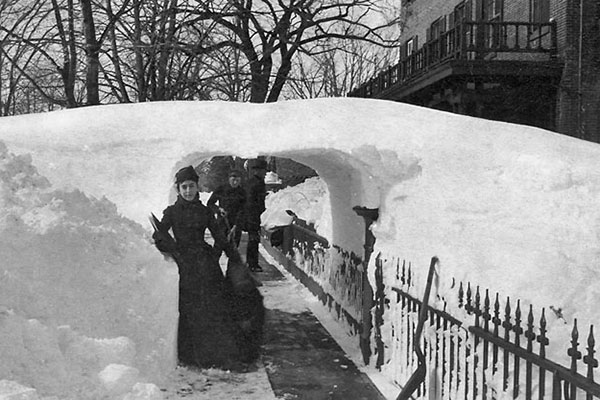‘Tis the season for snow and the Conservancy’s Technical staff has tips on protecting your steps and sidewalk. This is just one of the ways the Conservancy offers free advice to property owners throughout the year.
Using a shovel may be the safest way to remove snow and ice from stoops and sidewalks without damaging the masonry of a building, but sometimes it is not enough. For this reason, de-icing products can provide additional help with the task of cleaning snow and ice. But they should be used with caution since they can potentially damage masonry surfaces, degrade mortar joints, and harm surrounding vegetation.
Various de-icing products formulated to melt snow and ice and make their removal easier are sold under different brand names at local hardware stores. Be careful however, when using these products. Repeated heavy applications can promote a slow but harmful process. Namely, the scaling and flaking of masonry surfaces. This action, called salt fretting, is often found where the base of the building meets the sidewalk. Continued use of de-icing products on masonry can cause severe fretting and the loss of pieces of masonry from the building or sidewalk.

HELPFUL HINTS
Using a de-icing product requires more than spreading it around. Knowing the age of a sidewalk and the product’s ingredients are important to prevent damage.
Before buying a de-icing product, consider the following:
• Concrete sidewalks and steps should be at least six months old, otherwise they can be severely damaged by de-icing products.
• Products containing ammonium nitrate and ammonium sulfate should never be used since these will break down even the most durable masonry materials.
• Applying de-icers near areas of vegetation can potentially harm plant life if strong enough concentrations build up in the soil.
• To provide better traction use sand in combination with a de-icer or by itself.
Here are several suggestions to help speed melting and minimize damage to masonry when using a de-icing product:
• Follow the manufacturer’s instructions for use and safety.
• Before applying, shovel and remove as much snow and ice as possible.
• Apply the product sparingly in the area of highest foot traffic.
• Apply the product away from the base of the building.
• Assist the melting process by shoveling and removing snow and slush, especially away from the building.
• In the spring, wash down sidewalks, building bases, and areas near vegetation to help disperse the residue of the product.
There are four primary deicing salts for ice and snow removal:
1. Sodium chloride also known as rock salt, is the most common deicing salt. Rock salt releases the highest amount of chloride when it dissolves. Chloride can damage concrete and metal. It also can pollute streams, rivers and lakes. It should be avoided.
2. Calcium chloride is another de-icing salt. It comes in the form of rounded white pellets. It can cause skin irritation if your hands are moist when handling it. Concentrations of calcium chloride can chemically attack concrete.
3. Potassium chloride is not a skin irritant and does not harm vegetation. It only melts ice when the air temperature is above 15 F. but when combined with other chemicals it can melt ice at lower temperatures. It is a good choice.
4. Magnesium chloride is the newest deicing salt. It continues to melt snow and ice until the temperature reaches -13 F. The salt releases 40% less chloride into the environment that either rock salt or calcium chloride.
Avoid the use of fertilizers sometimes sold as de-icers and traction agents. Those that contain nitrate and ammonium sulfate can rapidly disintegrate concrete.
Always follow label instructions when using a deicing product. Any de-icer can be mixed with equal parts sand in order to provide grit for additional traction.
Use de-icers moderately and remove residue during long thaws and again in spring.
